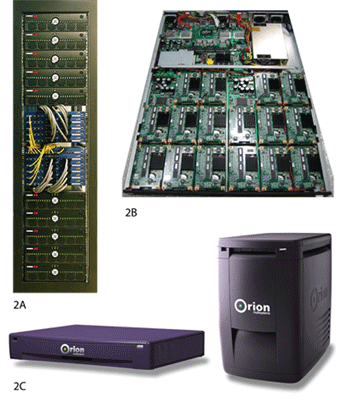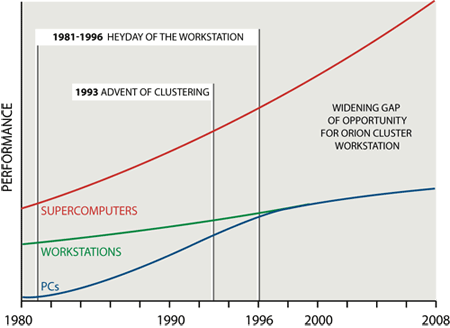The preceding work has now bifurcated into two different directions but both are still oriented towards reducing power consumption: (1) a low-power, architectural approach and (2) a power-aware, software-based approach.
In the arena of low-power architectures for HPC, there exist three related but distinct approaches. The first, and most natural, evolution of Green Destiny is the MegaScale Computing project whose goals are more ambitious than Green Destiny’s were. The MegaScale Computing project14 is a multi-institutional project that is looking towards building future computing systems with over a million processing elements in total. Like the Supercomputing in Small Spaces project, the MegaScale Computing project aims to simultaneously achieve high performance and low power consumption via high-density packaging and adopting low-power CPUs, but with the loftier design goals of one Tflop/rack, 10 kW/rack, and 100 Mflops/W. Similar to Green Destiny, their first prototype of an ultra low-power MegaScale system, called MegaProto, also leverages Transmeta CPUs, which deliver very low power but reasonable HPC performance, resulting in extraordinary performance-power ratios.15 A picture of their MegaProto prototype that was demonstrated at SC2004 is shown in Figure 2b; it is a 16-CPU low-power cluster with dual Gigabit Ethernet for data communication and Fast Ethernet for management and control — all in a compact 1U chassis that consumes only 330 W. (As a point of reference, a traditional dual-CPU compute node consumes 250 W of power. Thus, for 16 CPUs, the aggregate power consumption would run on the order of 2000 W and would then need an additional 1400 W of power to cool the system for a total of 3400 W, or over ten times more power consumption.)
The second and more modest architectural approach to low power is a commercial evolution of Green Destiny, as embodied by Orion Multisystems.16 The company has two offerings: the DT-12 (i.e., DeskTop-12 nodes) and DS-96 (i.e., DeskSide-96 nodes), as shown in Figure 2c. Their offerings are intended to fill the widening performance gap between PCs and supercomputers, as shown in Figure 3, whereas the ultimate goal of the MegaScale Computing project is to create the capability of constructing a supercomputer with one-million processing elements.
Orion Multisystems identified three technology trends that make their offerings ideally positioned as the cluster workstation of the future: (1) the rise of cluster-based high-performance computers, (2) the maturity of open-source cluster software, and (3) the rapid decline of the traditional workstation. By placing a cluster workstation at the hands of an applications scientist, it can be more naturally used as a dedicated personal resource - application debugging with scalability at the desktop, redundancy possibilities whenever the datacenter HPC resource is down and unavailable, and no more scheduling conflicts or long queues for access to a datacenter HPC resource. And perhaps most importantly, by leveraging low-power components, both the DT-12 and DS-96 can be plugged into a standard electrical wall outlet in any office, as the former only consumes as much power as an overhead light with two 75-W light bulbs and the latter consumes as much as a typical hairdryer, i.e., 1.5 kW.








